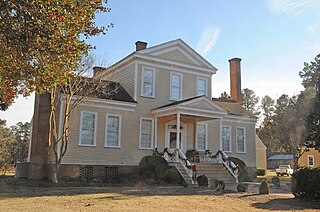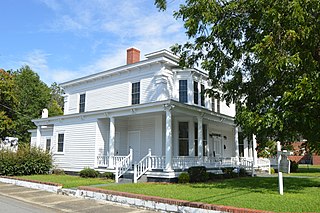
The James Iredell House is a historic home located at Edenton, Chowan County, North Carolina. The original section was built 1800, and expanded to its present configuration about 1827. It is a two-story, "L"-shaped frame dwelling with Georgian and Federal style design elements. It was the home of James Iredell, an ardent patriot and Justice of the Supreme Court.
Brown–Graves House and Brown's Store is a historic plantation complex located near Locust Hill, Caswell County, North Carolina. The plantation house was built about 1800, and is a two-story, five bay, Late Georgian style frame dwelling. It is set on a stone basement and has a low hipped roof. The front facade features a one-story pedimented porch with Corinthian order columns. Brown's Store is located across from the house and is a one-story, gabled frame building with a single shouldered stone and brick chimney. Also on the property are the contributing two slave quarters, a smoke house, and a Greek Revival period law office.
Piney Prospect, also known as the Sugg House, is a historic home located near Tarboro, Edgecombe County, North Carolina. The original house was built about 1800, and enlarged to its present size about 1820. It is a two-story, rectangular, frame dwelling in the Early Republic style. It features a four-bay, two-tiered recessed porch with three free standing and two engaged columns. The interior has Adamesque design elements. Also on the property is a large barn built about 1860.

Patty Person Taylor House is a historic home located near Louisburg, Franklin County, North Carolina. It was built about 1783, and is a two-story, five bay, Georgian style frame dwelling. It has a gable roof and one-story rear extension. It has a center-hall plan one room deep, with notable Georgian woodwork. It was the home of the sister of Thomas Person (1733-1800), who died at the house in 1800.
Red Hill is a historic plantation house located near Bullock, Granville County, North Carolina. The house consists of three parts: a 1+1⁄2-story, two-bay gambrel-roofed Georgian style center block built about 1776; a 1+1⁄2-story, two-bay one-room, gable-roofed Georgian style block with transitional Federal features, built about 1807; and a very tall two-story, three-bay, transitional Federal/ Greek Revival style addition, built about 1820, style frame I-house dwelling. It has a full basement, full width front porch, and exterior brick chimneys. Across from the house is the 2+1⁄2-story heavy timber frame tobacco manufactory. Also on the property are the contributing wash house / striphouse, open wellhouse, smokehouse, privy, and flower house / chicken house.
Shaw-Cude House is a historic home located near Colfax, Guilford County, North Carolina. It consists of two principal sections: a single-pen, 1+1⁄2-story log structure with an exterior end chimney, probably erected between 1790 and 1800; and the larger 2+1⁄2-story block, of brick construction, probably built about 1809. The house incorporates Late Georgian and Greek Revival style design elements and embodies stylistic elements of Quaker architecture.
Matthews Place, also known as Ivey Hill, is a historic plantation house located near Hollister, Halifax County, North Carolina. It consists of two houses: a two-story, three bay, Georgian-style frame dwelling dated to about 1800, attached to a two-story, three bay, Greek Revival-style frame dwelling added about 1847. The houses are set a right angles to the other. The older house has a single-shoulder brick chimney. The Greek Revival house features a pedimented front entrance porch with simple fluted Doric order columns.

The Hermitage, also known as Tillery House, is a historic plantation house located near Tillery, Halifax County, North Carolina. It was built about 1810, and is a tripartite house that consists of a two-story, three bay, pedimented central block flanked by one-story, two bay, wings. An exterior end chimney rises at the end of each wing and at the rear of the very long central block.
King-Flowers-Keaton House is a historic home located near Statesville, Iredell County, North Carolina. The house was built about 1800, and is a two-story, five bay by two bay, transitional Georgian / Federal style frame dwelling. It has a gable roof, rear ell, and two single shoulder brick end chimneys. Also on the property is a contributing outbuilding.
Feimster House was a historic home located near Statesville, Iredell County, North Carolina. It was built about 1800, and is a 1+1⁄2-story, three bay by two bay, frame transitional Georgian / Federal style dwelling. It had a steeply pitched gable roof and rested on a high fieldstone foundation. It has been demolished.

Eagle Nest is a historic plantation house located near Pink Hill, Jones County, North Carolina. It was built about 1800 and is a two-story, four-bay by three-bay, Federal style frame dwelling. It rests on a brick foundation, is sheathed in weatherboard, and has a gable roof with exterior end chimneys. It has two one-story frame rear additions. The front facade features a two-tier engaged porch with an enclosed east end. Also on the property is a contributing smokehouse.
Holly Bend, also known as Hollywood, is a historic plantation house located near Huntersville, Mecklenburg County, North Carolina. It was built between 1795 and 1800, and is a two-story, five bay by two bay, frame dwelling with Federal style design elements. It has gable roof, brick exterior end chimneys, and a one-story, full-width, hip roof porch.
Black Jack, also known as John Hilliard House, is a historic plantation house located near Red Oak, Nash County, North Carolina. It was built about 1800, and is a two-story, three bay by two bay, Late Georgian / Federal style frame dwelling with one-story rear additions. It was listed on the National Register of Historic Places in 1974.

Burleigh, also known as the McGehee-Phifer Plantation, is a historic plantation house located near Concord, Person County, North Carolina. It was built between about 1800 and 1820, and is a 2+1⁄2-story, vernacular Late Georgian central hall plan symmetrical frame dwelling. The front and facades features Greek Revival style, one-story, temple front porticoes with Doric order columns. The interior has Late Federal and Greek Revival style design elements.
Dupree–Moore Farm, also known as the Thomas Dupree House, is a historic home and tobacco farm located near Falkland, Pitt County, North Carolina. The house was built between about 1800 and 1825, as a 1 1/2-story, three bay, frame dwelling. It was enlarged to two stories and rear additions added and remodeled in the Greek Revival style about 1848. A two-story rear "T" addition was added about 1861. The house features a one-story full-width shed-roof front porch with Picturesque-style latticework. Also on the property are the contributing smokehouse, tobacco grading house, pump house/utility shed, frame equipment shelter, mule barn, tobacco packhouse, tenant house, tenant tobacco packhouse, sweet potato house, log tobacco barn, tobacco barn, and tobacco packhouse.

Patrick-Carr-Herring House, also known as the Second Sampson County Courthouse, is a historic home located at Clinton, Sampson County, North Carolina. It was built about 1904–1905, and is a two-story, three bay, double pile, Classical Revival / Greek Revival style frame dwelling with a low-pitched hip roof. It was originally built as a 1+1⁄2-story structure on tall brick piers in 1818, and enlarged to a full two stories in the Greek Revival style on a full one-story brick basement in the 1840s. It was moved to its present site, and remodeled, in 1904–1905, when the current Sampson County Courthouse was constructed. The front features a single-story wraparound porch with Tuscan order columns and bracketing. Also on the property is a contributing smokehouse.

Stewart-Hawley-Malloy House is a historic home located near Laurinburg, Scotland County, North Carolina. It was built about 1800, and is a transitional Georgian / Federal style frame dwelling. It consists of a two-story, five bay by two bay, main block with a one-story, two bay by four bay, wing. The main block has a full-width, one-story front porch and rear shed additions. It was built by North Carolina politician James Stewart (1775-1821) and the birthplace of Connecticut politician Joseph Roswell Hawley (1826-1905).
Powell House is a historic plantation home located near Wake Forest, Wake County, North Carolina, USA. It was built about 1800, and is a large two-story, five bay, Federal-style frame dwelling. The house has two one-story rear additions and exterior end chimneys. The front facade features a full height portico added about 1940.

Green Duke House is a historic plantation house located at Soul City, near Manson, Warren County, North Carolina. It was built about 1800 as a Georgian style dwelling, and remodeled in the post-Victorian style about 1900. It is a two-story, five bay, frame dwelling with a hipped roof. The front and rear facades feature one-story porches with elaborate Ionic order columns. At the time of its listing, the house was being used as a day care center.
Mary Ann Browne House, also known as Oakley, Oakley Grove, Faulcon-Browne House, and Dr. LaFayette Browne House, is a historic plantation house located near Vaughan, Warren County, North Carolina. It consists of a 2+1⁄2-story, Italianate style rear wing built about 1800, with a main block added about 1855. The main block is attributed to Warrenton builder Jacob W. Holt. It is a two-story, three bay, single pile, Greek Revival / Italianate style frame block. It has a low hipped roof and Tudor arched windows.












